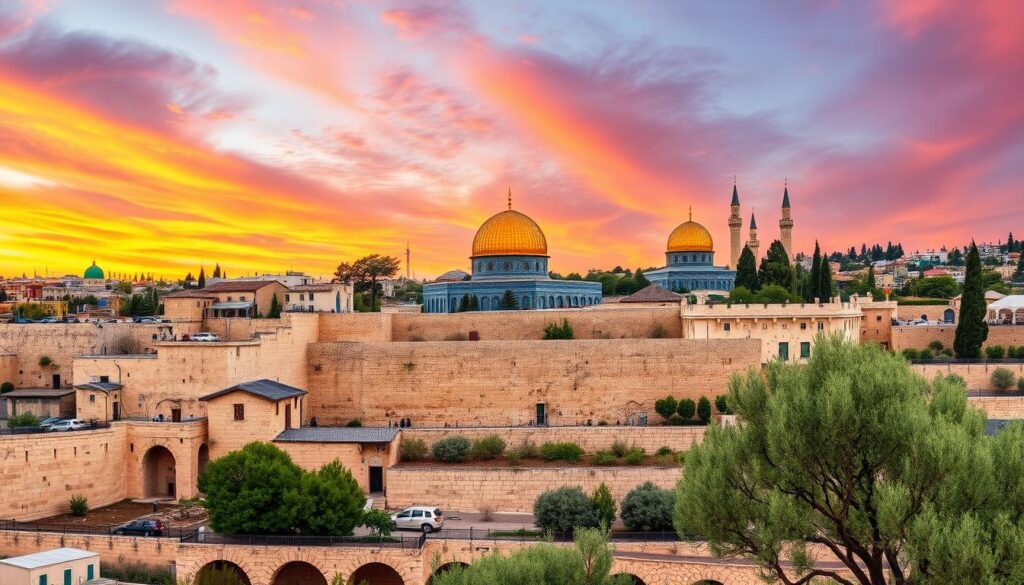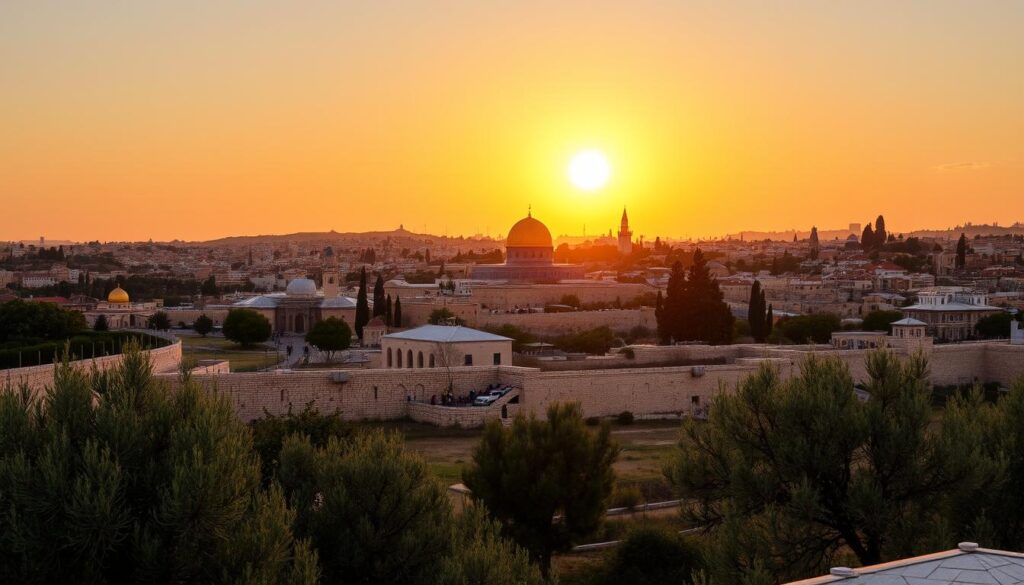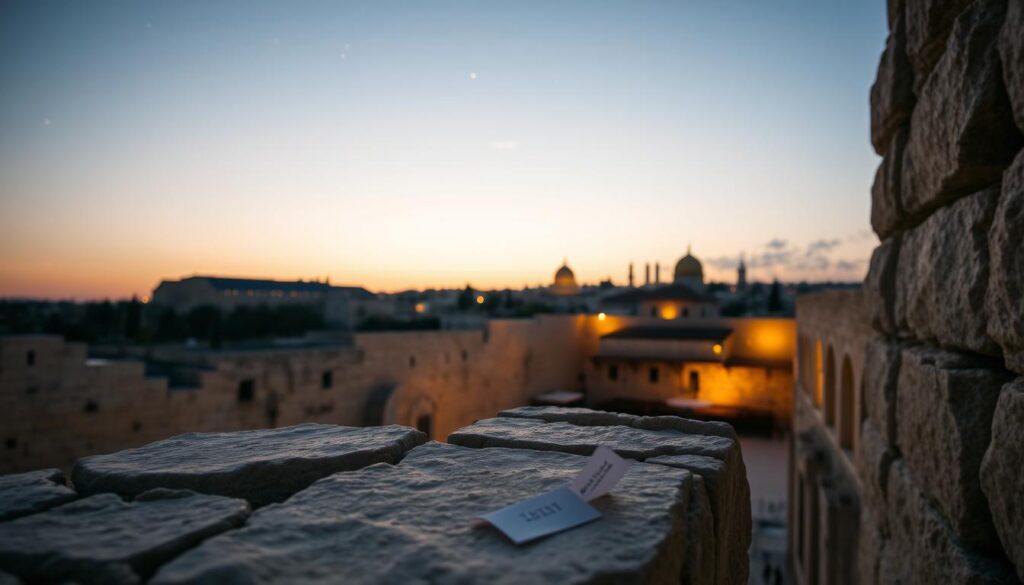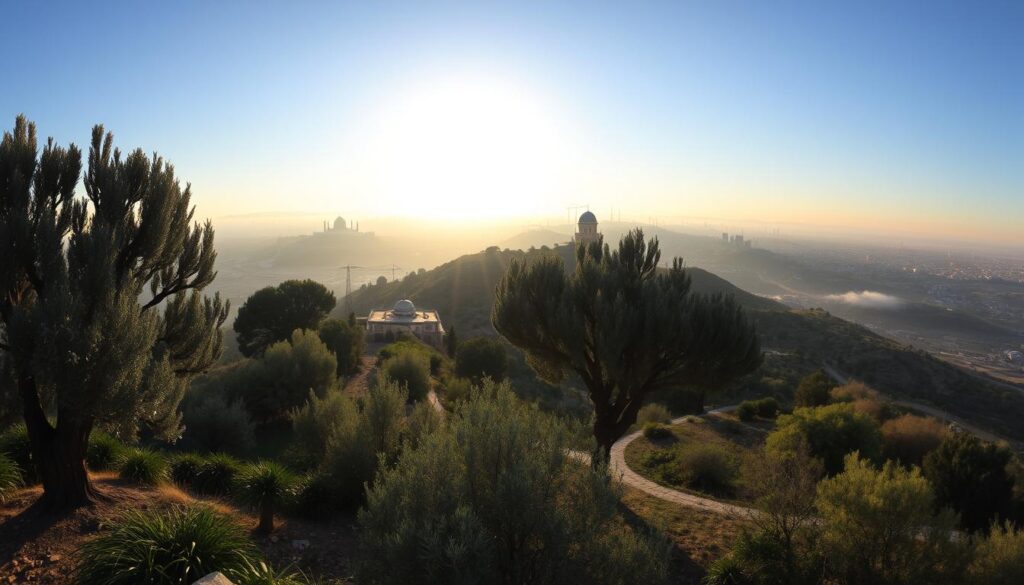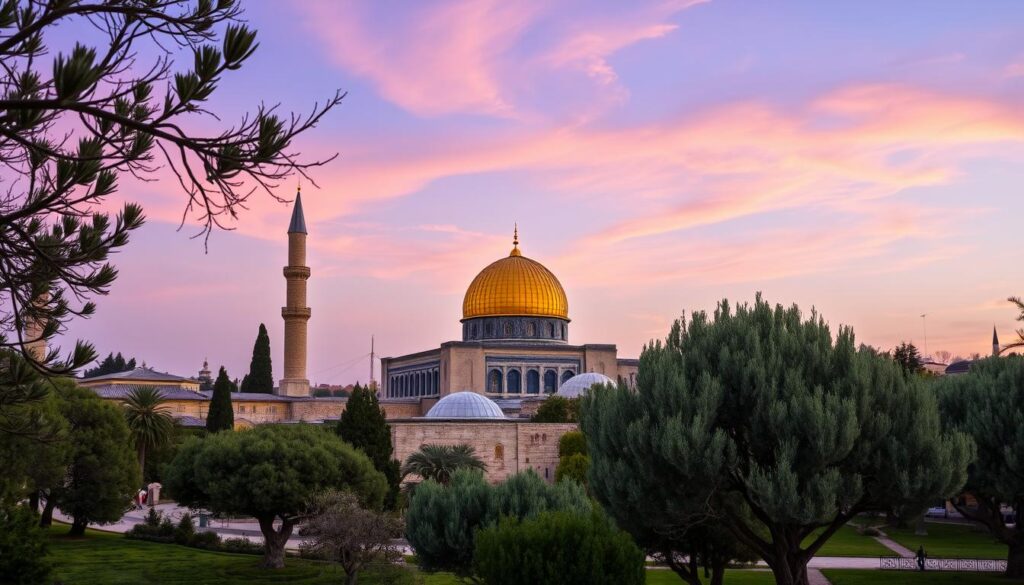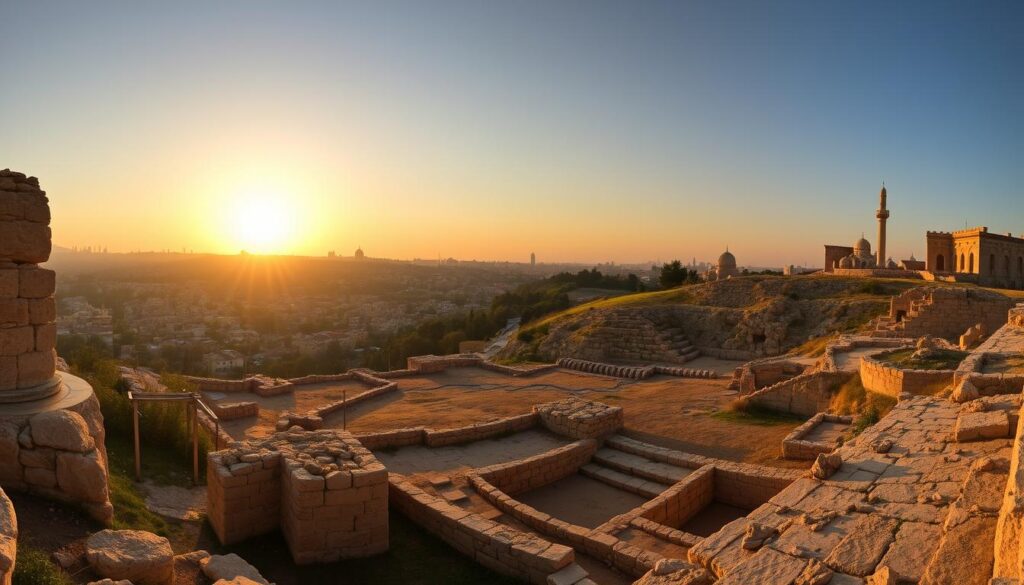As I walk the ancient streets of Jerusalem, a deep sense of awe and respect fills me. This place is where the old and new meet, where the holy and everyday life blend. From the high Temple Mount to the calm Sea of Galilee, Israel’s holy spots invite us to explore faith and culture.
This special country, known as the Holy Land, is a mix of many faiths, each with its own story. Whether you’re deeply religious or just curious, these places will touch your heart. They connect us to the long history of human belief and the lasting power of faith.
Key Takeaways
- Explore the rich religious history and diverse cultural landscape of Israel’s holy sites.
- Discover the profound connections between faith, history, and the land in this remarkable destination.
- Immerse yourself in the spiritual tapestry that has woven the fabric of this remarkable land.
- Gain a deeper understanding of the significance of these sacred places for believers and curious travelers alike.
- Embark on a journey of spiritual discovery and cultural enlightenment in the Holy Land.
Understanding the Sacred Landscape of Israel
Israel’s landscape is filled with history, religion, and holy sites. It’s important for Judaism, Christianity, and Islam. Places like Jerusalem’s Old City and the Sea of Galilee hold deep spiritual value.
Historical Significance of Holy Sites
Israel’s holy sites are centuries old. They’ve seen the rise of the Abrahamic religions. Visiting these sites helps us understand the past and the Christian pilgrimage and Jewish heritage sites.
Religious Diversity in the Holy Land
Israel is a mix of religious diversity. You’ll find Islamic holy sites, Christian churches, and Jewish synagogues. This shows the land’s spiritual importance for all faiths.
Geographical Distribution of Sacred Places
Sacred places in Israel are everywhere. From Jerusalem to Galilee, there’s much to see. Each place offers a unique view of Israel’s religious and cultural heritage.
| Holy Site | Religious Significance | Historical Importance |
|---|---|---|
| Temple Mount | Holiest site in Judaism, third-holiest site in Islam | Site of the First and Second Temples, location of the Dome of the Rock |
| Church of the Holy Sepulchre | Believed to be the site of Jesus’s crucifixion, burial, and resurrection | One of Christianity’s holiest sites, visited by pilgrims for centuries |
| Al-Aqsa Mosque | Third-holiest site in Islam, believed to be where Prophet Muhammad ascended to heaven | Constructed in the 7th century CE, the mosque has been a significant Islamic site for over a millennium |
“Exploring Israel’s sacred landscape is a profoundly enriching experience, offering a window into the region’s complex history and the enduring spiritual traditions that have shaped it.” – Dr. Sarah Levi, religious historian
The Heart of Jerusalem: Temple Mount and Western Wall
At the heart of Jerusalem is the Temple Mount, a site of great religious importance. It sits at 740 meters (2,430 feet) high. This 35-acre (14-hectare) area was once home to the original Jewish temple.
The Western Wall, also known as the Kotel or Wailing Wall, is a piece of the ancient walls. It’s a key spot for the Jewish faith. People come to pray and leave notes in the wall’s cracks.
“The Temple Mount is considered the holiest site in Judaism and where two Jewish temples once stood.”
The Temple Mount is a source of conflict. The Muslim community manages it, with Israel controlling security since 1967. Jews and Christians face strict rules when visiting.
The Western Wall has a special area for prayer, the Ezrat Yisrael. Here, different Jewish groups can pray together. The site is open all day and night, with ongoing excavations uncovering history.
The Temple Mount and Western Wall are central to the Israeli-Palestinian conflict. They hold deep religious, historical, and political value. These sites draw visitors from all over, inspiring and captivating them.
Mount of Olives: A Sacred Ridge of Faith
The Mount of Olives stands tall over Jerusalem, reaching 826 meters (2,710 feet) high. It’s a place of deep faith for Jews, Christians, and Muslims. This mountain offers a stunning view of the city, marking key moments in religious history.
Garden of Gethsemane
At the Mount of Olives’ base is the Garden of Gethsemane. It’s where Jesus prayed before his crucifixion. The garden is home to ancient olive trees, over 2,000 years old, creating a peaceful spot for reflection.
Chapel of Ascension
The Chapel of Ascension is where Jesus is believed to have ascended to heaven. This octagonal chapel, with its central dome, symbolizes the Mount of Olives’ importance in Christian faith.
Tombs of the Prophets
The western slopes of the Mount of Olives house the Tombs of the Prophets. These tombs are said to hold the remains of Haggai, Zechariah, and Malachi. This ancient Jewish cemetery shows the mountain’s lasting spiritual impact.
The Mount of Olives has been a center of religious life for thousands of years. Its sites attract visitors worldwide, seeking to connect with its rich history and spiritual essence.
| Key Facts about the Mount of Olives | Values |
|---|---|
| Coordinates | 31°46′42″N 35°14′38″E |
| Elevation of Highest Point | 826 m (2,710 ft) |
| Length of Mountain Ridge | 3.5 km (2.2 miles) |
| Graves in Jewish Cemetery | Approximately 150,000 |
| Tombstones Damaged During Jordanian Rule | 38,000 |
Via Dolorosa and the Church of the Holy Sepulchre
The Via Dolorosa in Jerusalem is very important for Christian pilgrims. It’s the path Christ took to his crucifixion. The Church of the Holy Sepulchre, at the end, is a key site in Christian pilgrimage. It’s where Jesus was crucified, buried, and resurrected.
The Via Dolorosa is about 500 meters long in Jerusalem’s Old City. It starts at the Umariyya School, near St. Stephen’s Gate. Franciscan friars lead the procession on Fridays, starting at 4 pm or 3 pm in winter.
Historically, the Stations of the Cross have changed, from 7 to 18 or more. Today, we have 14 stations, based on the Gospels and tradition. These include Jesus’ falls and his meeting with his mother.
The Church of the Holy Sepulchre is a shared site for Christians. It welcomes over one million pilgrims yearly. The site was found in the 4th century, thanks to Emperor Constantine and his mother, Helena.
“The Via Dolorosa in Jerusalem is a processional route in the Old City stretching about 600 meters (2,000 ft) from the former Antonia Fortress to the Church of the Holy Sepulchre.”
Islamic Holy Sites: Al-Aqsa Mosque and Dome of the Rock
The Al-Aqsa Mosque and the Dome of the Rock are key Islamic sites on the Temple Mount in Jerusalem’s Old City. The Al-Aqsa Mosque is where Prophet Muhammad had his Night Journey. It’s the third most sacred place in Islam. The Dome of the Rock, with its golden dome, was built in 691-692 CE by Umayyad Caliph Abdul Malik ibn Marwan.
These sites are very important to Muslims all over the world. Visitors need to know about dress codes and access rules, especially during prayer times. The Al-Aqsa Mosque can hold over 4,000 Muslims during worship.
The Temple Mount, home to the Al-Aqsa Mosque and the Dome of the Rock, is over 14 hectares in size. The mosque has a big interior with seven rows of columns and a mihrab facing Mecca. There’s also a small mosque called the Mosque of Omar nearby.
| Key Facts | Details |
|---|---|
| Al-Aqsa Mosque Size | Spans over 14 hectares of land |
| Gates | Traditionally had 15 gates, but only 10 are currently in use |
| Total Area | 144,000 square meters, incorporating mosques, prayer rooms, and courtyards |
| Water Sources | 32 water sources, including wells used for ablutions |
| Dome of the Rock | Built between 691-692 CE by the Umayyad Caliph Abdul Malik ibn Marwan |
| Western Wall | Stands around 20 meters tall and 50 meters in length |
The Al-Aqsa Mosque has been rebuilt many times. A 1000-year-old pulpit was destroyed in 1969 by an Australian tourist. Non-Muslims can visit the Temple Mount but not the mosque or the Dome of the Rock.
“If given the chance, I would build a Jewish synagogue on the holy site.”
– Itamar Ben-Gvir, Israeli official
The Al-Aqsa Mosque and the Dome of the Rock are often at the center of controversy. Some Israeli officials, like Itamar Ben-Gvir, want Jews to pray at the site. But, international leaders see this as provocative and a breach of agreements.
The City of David: Archaeological Treasures
Nestled just outside Jerusalem’s Old City walls, the City of David is a treasure trove of history and biblical tales. This ancient settlement, covering about 50 dunams, holds remnants from the Chalcolithic and Early Bronze Ages. It also shows signs of growth during King Solomon’s reign.
Gihon Spring and Pool of Siloam
The City of David National Park is home to 11 archaeological sites west of the Kidron Valley. It showcases artifacts from the Middle Bronze Age and defensive structures around the Gihon Spring. The Pool of Siloam, mentioned in the New Testament, is also here. It highlights the sacred waters’ importance in ancient times.
Ancient Walls and Fortifications
Excavations have revealed the city’s ancient walls and fortifications. These include structures possibly repaired by Nehemiah. The Siloam Tunnel, dating back to Hezekiah’s reign in the 8th century BCE, has sparked debate. Some think it might be even older.
Biblical Archaeological Discoveries
Excavations at the City of David continue to find biblical treasures. They connect the city’s history to religious texts. From ancient artifacts to architectural wonders, this site offers a peek into the past. It fascinates both visitors and scholars.
| Key Facts | Details |
|---|---|
| Size of the City of David site | Approximately 50 dunams (12.3 acres) |
| Historical periods covered | Bronze Age to Byzantine period |
| Notable archaeologists involved | Charles Warren, Conard Schick, K.M. Kenyon, Yigal Shiloh, Ronny Reich, Eli Shukron, Doron Ben-Ami, Eilat Mazar, and more |
| Duration of research and excavations | Late 19th century to contemporary times |
| Stepped-stone structure | Believed to date from before the 10th century BC, served as a retaining wall for David’s palace or the Canaanite fortress |
| Hezekiah’s Tunnel | 530-meter tunnel dug in the 7th century BC to bring water to the Pool of Siloam |
| Canaanite tunnel | Provides an alternative route to Hezekiah’s Tunnel for visitors |
| Roman sword discovery | Found in a tunnel that served as a drainage channel from the Old City to the Kidron Valley in Roman times |
The City of David is a window into the biblical archaeology of the region. It invites visitors to explore the ancient archaeological sites that have captivated scholars and historians for centuries.
“The City of David is a place where the past and present intersect, offering a glimpse into the complex and fascinating history of this sacred land.”
Sacred Waters: Sea of Galilee and Jordan River Sites
The Sea of Galilee and Jordan River are key in Jewish and Christian traditions. The Sea of Galilee is where Jesus taught and performed miracles. The Jordan River, especially at Qasr el Yahud, is where John the Baptist baptized Jesus. These waters attract pilgrims and tourists wanting to connect with biblical history and perform baptisms.
The Jordan River flows 200 miles from the Golan mountains to the Sea of Galilee. It drops almost 3,000 feet to the Dead Sea. It’s vital for drinking water and farming. In the 19th century, thousands of Christian pilgrims visited the Jordan River each year.
The site of Jesus’ baptism is in Jordan at el-Maghtas. Archaeologists confirm it’s the spot. It’s now a park with a Byzantine monastery and churches.
The Yardenit baptism site in Israel is at the Sea of Galilee‘s southern end. It’s where Christians renew their baptismal vows. Before the 1994 peace treaty, the Jordan site was off-limits due to military use.
The lower Jordan River faces pollution from sewage and industrial waste. Over 90% of its flow is used for homes and farms. This highlights the need to protect this sacred river.
“The Jordan River is the primary source of drinking water for the region and is crucial for agriculture.”
Bethlehem and Nazareth: Birthplace and Hometown of Jesus
Bethlehem and Nazareth are key places in Christianity. Bethlehem is where Jesus was born, and Nazareth is where he grew up. The Church of the Nativity in Bethlehem is one of the oldest churches still in use. It was built in 339 AD by Roman Emperor Constantine and his mother, Helena.
Over the years, the church has been restored many times. The latest restoration cost $25 million. It’s a place of great importance for Christians.
Church of the Nativity
The Church of the Nativity is near Manger Square and Manger Street. It has a silver star that shows where Jesus was born. The church also has chapels for Saint Joseph and the Innocents.
Bethlehem was once home to 1,000 to 3,000 people. It has been ruled by many, including Turkey, Britain, Jordan, and Israel. This has led to many Palestinians living in nearby refugee camps.
Basilica of the Annunciation
In Nazareth, the Basilica of the Annunciation is where Mary was told she would have a son. This is where Jesus grew up and shared his message. The Nazareth Community lives by Jesus’ teachings, focusing on friendship, silence, and scripture.
